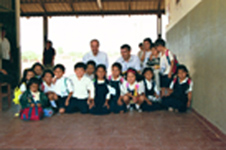Facilities
Currently, the community of Idente Missionaries occupies three different areas in Bolivia;
Santa Cruz
the country's second largest city; and
San Miguelito and
San Ignacio del Velasco remote towns near the border of Brasil.
Santa Cruz



Missionaries administrate two different day schools and one night school
on one campus. Each
school serves a different group of students and is also formed by a different
principal and faculty. The total number of students served is 2000. The elementary school operates from 8 am to 12:30 pm; then the high school operates from 2 to 6:30 pm and then again from 7 to10 pm in the evening at which time a vocational component is added. The children are well behaved and are interested in learning and the tender atmosphere shared by the administration and faculty enhances this.
The school is part of the parish of St. Peter and St. Paul in the Guracal area of Santa Cruz. The Parish was constructed by the missionaries and local city dwellers in the late 1980's shortly after the adjacent school that was built in the mid 1980s, when the missionaries had first arrived. In addition to this Main Parish the missionaries also serve at five other out post churches, or chapels as they are called, that are also apart of this Parish.
The missionaries also built the kindergarten and first grade and the area provides ample space for needed expansion. Adjacent and apart of the Parish and school is also a medical facility including three examination rooms and a dentist operating room.
The missionaries also constructed a recreational square that provides a place for the children to exercise in inclement weather, but only two sides of the structure have walls. It also functions as an auditorium, having a small stage for school productions and graduations.
After the missionaries constructed the parish school and medical facility
next to it, the municipality constructed a town square.
San Miguelito




San Miguelito is a boarding school and farm administrated by the missionaries in a remote part of Bolivia, near the border of Brasil. The children who attend this boarding school are some of the more fortunate, as there is no tuition. The missionaries are able to provide a complete academic and agricultural education for these boys as well as room and board, all financed from the raising and sale of cattle. The farm is approximately four square miles and is the home of a herd approximately 1,000 cattle.
One of the greatest needs in this area is to raise additional money to afford the small children in surrounding area a simple glass of milk each day. The nutrition
in this region is terrible, and it has been determined that supplying a fresh glass of milk daily to these children will make an enormous difference in
their health and growth.
San Ignacio de Velasco


In San Ignacio de Velasco the missionaries administrate two day schools on two
campuses. With the help of volunteers, the missionaries have constructed
additional classrooms and buildings. The children at their schools have their
nutrition supplemented through a milk program implemented by the missionaries.
These two day schools serve approximately 1000 day students. The missionaries
also administrate the local university in this region. While the university
currently serves only a small number of students, the bishop in the area has
aided the missionaries in procuring a site for a university campus. With the
help of architectural volunteers from Spain, the missionaries have
architectural drawings for the university.





